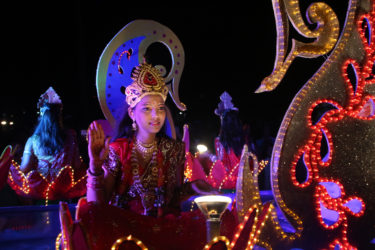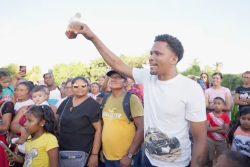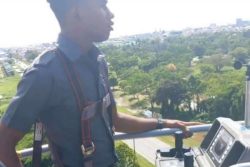Cultural change continues to be a very interesting study. We have from time to time commented on factors of change in Guyana and the Caribbean and have remarked at what has been observed in some cultural traditions. We have turned our attention to traditional and religious festivals and the way changes have occurred over time and place where these festivals are celebrated.
On this occasion this can be narrowed down to religious festivals and in particular, to the Hindu Festival of Diwali (Deepavali). Traditions take a very long time in evolving, establishing themselves and suffering change. But in a relatively short time a number of significant developments have been observed in Diwali in Guyana. These have been the result of time and place, urban and rural setting, cultural infiltration, acculturation, cultural diffusion, traditional retention, the influence of modernity, advancing technology and popular culture.

Diwali is a Hindu festival with origins in India but it has grown stronger in a number of ways, while experiencing a few downward trends in the way it has been observed in Guyana and Trinidad and Tobago since indentureship. It is now very vibrant in Guyana and has a very large outreach, unlike other traditions that have waned. It shares this robust increase with the other major Hindu festival of Phagwah, as both have seen cultural change including extensions beyond Hinduism. Both are religious calendar events but have transcended that to become traditional, cultural, and popular.
Diwali is religious and that is its primary function. It is called the Festival of Lights because of its purpose and its form. It is an annual calendar ritual in which devotees pay homage to the goddess Lakshmi who is a deity for light, wealth and prosperity. Religious rituals including puja are practiced by the believers in private at home and in holy temples. These include personal asceticism, preparation and purging such as the cleaning of the premises and personal abstinence as prerequisites for the ritual practices and the lighting of diyas.
But like all large religious festivals it is built on belief which is demonstrated in private and exclusive sacred ceremonies but also expresses itself in grand public outreach with visual, spectacular and symbolic manifestations. Sacred belief is expressed through literature, mythology, stories and symbols.
Devotees pray to Lakshmi for her blessings and prosperity; the festival promotes the prevailing of light over darkness, the conquest of good over evil and invites the goddess into the homes and the lives of the believers. Belief is publicly and spectacularly expressed through lights which are symbolic of Lakshmi as the goddess of light. Diyas are lit on parapets, along gateways, on the outside of houses in order to invite the deity in.
Mythology, stories and literature also play a role. It is said, additionally, that the night when Lord Ram returned home from exile to Ayodhya to reclaim his kingdom after his victory over Rawan was the darkest night of the year and the people of Ayodhya lit thousands of diyas to, guide and welcome him home. This is said to be the origin of Diwali. It also fits into the themes and symbolism.
The burning of diyas and the display of other lights, therefore, are the public outreach of the festival which broadcast the religious messages, symbolise belief and make visual spectacular appeals to the public at large. Even those who are not believers take great delight in looking at the flamboyant displays of lights. This is one way in which the festival is popular. Large crowds also gather to see the Diwali motorcade lining the route taken by the lighted and decorated vehicles.
Public displays also include the rangoli. These are also known as rice drawings – grains are dyed in various bright colours and used to make large colourful drawings on the ground. These depict symbols and scenes sacred to Hinduism or even tell stories as in a tapestry, and there is an inter-faculty competition for the best rangoli on the University of Guyana campus at Turkeyen. Additionally, as in the case of Phagwah, there are concert performances of dance, song, music and drama at mandirs and other venues as part of the festival’s public celebration.
The motorcade, which also has competitions for the best vehicular floats, is a grand popular affair and only Mashramani sees more people out on the streets at a single festival.
Those exhibitions are mentioned because they constitute the popular outreach that is a part of the religious festival. They also make it a popular, even secular festival. This popularity has also become a factor of cultural change. Because of this appeal that attracts wide cross sections of the population, the popular culture exerts some influence. This involves a certain degree of feting on the streets on Diwali night. In some areas around Georgetown large crowds gather entertaining themselves with revelry and music, a significant activity around Alexander Village, Albouystown, La Penitence and Charlestown.
This is a factor of cultural change not unlike what has been observed in Trinidad at both Diwali and Phagwah. The story of the evolution of this activity, however, has not been a happy one in places like Alexander Village where police action is now an annual feature, owing to the abuse of firecrackers and the resort to vandalism.
Other elements have been more interesting. The popular culture as a whole, coupled with modernity and new technological thinking has seen a gradual encroachment upon the use of diyas for lighting. Electric, fairy lights have become heavily used to light houses, sometimes replacing or used in tandem with the traditional diyas. One may speculate whether these ancient lamps will eventually totally give way to electricity.
Field research carried out on the Essequibo Coast within the past decade revealed the most intriguing elements of cultural change when comparing rural Guyana with urban and when looking at the motorcade in Georgetown over the last 7 – 10 years. There have been retention, diffusion, and even a reversal from ancient to modern.
The rural motorcade between places, such as Walton Hall, Anna Regina and Adventure is the climax of celebrations there and several elements of retention observed there had faded away in Georgetown. These include the use of animal-drawn vehicles on which the lighted and decorated floats are mounted. Oxen/bullocks are common in the street parades along with motor vehicles, and one gets the impression these are relics of the past that have not been dispensed within the country areas.
Next, live human actors and models outnumber effigies and lighted images on these vehicles. Persons, including children, are costumed as Hindu gods and deities and there are many tableaux depicting pastoral scenes and members of the Hindu pantheon. What is found there, too, is a greater presence of the god Ganesh, also worshipped at Diwali, as well as Sarswati to a lesser extent. Live music is also provided as opposed to recorded music, and this is prevalent on the streets in Essequibo. Costumes, masks and effigies are fashioned and built in the same way as mas costumes for a carnival. This has been the practice rather more than clever creations fashioned from the use of electric lights as is common in the capital city.
Then there was the use of bamboo in the rural areas which was not so prevalent in Georgetown until it became widely used in parts of Prashad Nagar. With some creativity, bamboo is split and bent over in arches along which lights are placed resulting in fine spectacular designs; these are widely seen in Trinidad. That too, seemed to be an old tradition introduced in recent years outside the home of Pandit Reepu Daman Persaud, late leader of the Guyana Hindu Dharmic Sabha.
What is very intriguing about these older traditional practices is the following. As the Georgetown to La Bonne Intention motorcade developed in Georgetown, most of the more ancient practices gave way to modernity, motor vehicles with no place for cattle; music was mostly recorded and the vehicles were decorated by artistically manipulated electric lights forming various images and other devices to show symbols and sacred designs.
But over the past five to seven years or so, there has been rapid rise in what may be termed a reversal. A fast growing number of floats consist of tableaux featuring live human actors and models. Goddesses are played by girls sitting on the top of vehicles; people are placed inside of trucks to depict the holy scenes, including Ganesh, and live models are now as many as the artistically created effigies and ‘mas’ figures. Live music is now prevalent with groups of singers and instrumentalists sitting in trucks.
Yet this reversal is a move forward, because it has diversified the offerings and the possibilities to be explored by the costumed and decorated vehicles and made the competition fiercer and more interesting. At the same time it might have rescued elements of the traditions that could have become moribund. It also reflects a wider sense of theatre that has been so much a part of these cultural traditions in the Caribbean over the years.









